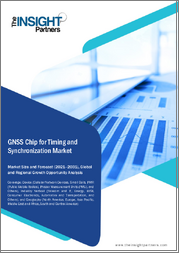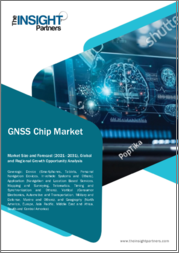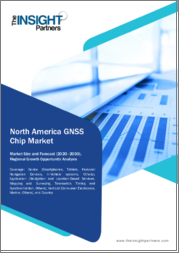
|
시장보고서
상품코드
1780310
타이밍 및 동기화용 GNSS 칩 시장 규모와 예측(2021-2031년) : 점유율, 동향, 성장 기회 분석 보고서 대상 : 장치별, 업계별, 지역별GNSS Chips for Timing and Synchronization Market Size and Forecast 2021-2031, Global and Regional Share, Trend, and Growth Opportunity Analysis Report Coverage: by Device, Industry Vertical, and Geography |
||||||
타이밍 및 동기화용 GNSS 칩 시장 규모는 2024년 1억 6,524만 달러에서 2031년에는 2억 9,009만 달러에 이를 것으로 예측되며, 2025년부터 2031년까지의 추정 CAGR은 8.7%를 나타낼 전망입니다.
타이밍 및 동기화용 GNSS 칩 시장 규모와 예측(2021-2031년) : 점유율, 동향, 성장 기회 분석 보고서 대상 : 장치별, 업계별, 지역별
타이밍 및 동기화용 GNSS 칩 시장 분석은 다음 부문을 고려하여 수행되었습니다
장치별 전 세계 타이밍 및 동기화용 GNSS 칩 시장은 셀룰러 네트워크 장치, 소형 셀, PMR(공공 이동 통신), PMU(페이저 측정 장치) 및 기타로 분류됩니다. 셀룰러 장치는 셀룰러 네트워크를 사용하여 음성 및 데이터 통신, 멀티미디어 서비스 및 원활한 로밍 기능을 제공하는 모바일 장치입니다. 최근의 셀룰러 네트워크에서는, 특히 5G와 같은 시분할 기반 시스템에서 네트워크 성능을 유지하기 위해 정확한 타이밍 및 동기화가 매우 중요합니다. 1G에서 5G로 셀룰러 네트워크가 발전함에 따라 속도가 빨라지고 지연 시간이 단축되었으며, 더 많은 수의 장치를 지원할 수 있게 되어 의료, 교통, 스마트 시티와 같은 산업에서 정교한 애플리케이션이 가능해졌습니다. 셀룰러 기기에 내장된 GNSS 칩은 기지국과 사용자 기기 간의 동기화된 전송 및 수신을 보장하기 위해 고도로 정확하고 일관된 타이밍 참조를 제공합니다. 5G 네트워크의 확장은 고도로 동기화된 인프라 컴포넌트에 대한 수요를 증가시키고 있으며, 이는 셀룰러 네트워크 수요 증가에 기여합니다. 모바일 네트워크의 지속적인 진화 속에서 GNSS 기반 타이밍은 셀룰러 인프라의 효율성과 안정성에 근본적인 역할을 계속할 것입니다.
또한, 5G 네트워크 인프라의 구축 증가, 데이터 센터 및 클라우드 서비스의 사이버 보안을 개선하기 위한 타이밍 및 동기화 용량에 대한 수요 증가와 같은 요인들이 타이밍 및 동기화용 GNSS 칩 시장의 성장을 촉진하고 있습니다. 또한, 하이브리드 타이밍 아키텍처는 향후 몇 년 동안 타이밍 및 동기화를 위한 GNSS 칩의 새로운 시장 동향을 가져올 것으로 예상됩니다.
산업 분야별 전 세계 타이밍 및 동기화용 GNSS 칩 시장은 통신 및 IT, 에너지, BFSI, 가전, 자동차 및 운송, 기타로 구분됩니다. 통신 및 IT 부문에는 무선 및 유선 통신 사업자, 데이터 센터, 클라우드 서비스 사업자, 기업 IT 인프라가 포함됩니다. 이 부문은 인터넷 액세스, 모바일 통신, 데이터 스토리지, 클라우드 컴퓨팅과 같은 서비스를 지원하여 전 세계의 연결성을 돕습니다. 통신에서 네트워크 성능과 무결성은 정확한 타이밍과 동기화에 크게 의존합니다. GNSS 칩은 기지국, 스위치, 라우터 및 데이터 센터에서 데이터 전송을 조정하고, 네트워크 노드 간의 핸드오버를 보장하며, 전반적인 서비스 품질을 유지하기 위해 정확한 시간 기준을 제공하는 데 사용됩니다. 타이밍은 시분할 다중화(TDM), 시분할 이중화(TDD) 및 LTE 및 5G NR과 같은 프로토콜에 매우 중요합니다. 정확한 동기화가缺如하면 이러한 시스템은 간섭, 연결 끊김, 데이터 전송 속도 저하 등 문제를 겪게 됩니다. GNSS 칩이 제공하는 정확성은 네트워크 동기화의 핵심 기반을 형성합니다. IT 및 클라우드 환경에서는 GNSS 타이밍이 로그 상관 관계 분석, 거래 타임스탬핑, 분산 데이터베이스 관리 등에 사용됩니다. 또한, 정확한 시간 측정은 사이버 보안 위협을 감지하고, 규정 준수를 보장하며, 전 세계에 분산된 데이터 센터에서 시스템 성능을 유지하는 데 도움이 됩니다. 5G는 고도로 동기화된 소형 셀과 네트워크 슬라이스가 필요하며, 이 모든 것은 GNSS 타이밍에 의존합니다. 따라서 5G 네트워크의 확장은 타이밍 및 동기화용 GNSS 칩 성장을 촉진하는 데 큰 역할을 합니다. 분산된 데이터 센터와 엣지 컴퓨팅 노드도 데이터 일관성과 보안을 위해 정확한 동기화가 필요합니다.
Broadcom Inc, Septentrio NV, Furuno Electric Co Ltd, Quectel Wireless Solutions Co Ltd, u-blox Holding AG, Protempis, LLC, Locosys Technology Inc, Novatel Inc., Safran SA 및 STMicroelectronics SV는 타이밍 및 동기화용 GNSS 칩 시장 보고서에서 소개된 주요 업체들입니다.
타이밍 및 동기화용 GNSS 칩 시장 전망은 주요 기업 보고서, 협회 데이터, 데이터베이스 등 다양한 2차 및 1차 연구 결과를 기반으로 추정되었습니다. 타이밍 및 동기화용 GNSS 칩 성장과 관련된 정성적 및 정량적 정보를 수집하기 위해 내부 및 외부 자료를 활용한 포괄적인 2차 연구가 수행되었습니다. 이 프로세스는 또한 모든 시장 부문에 대한 시장의 개요와 예측을 얻는 데 도움이 됩니다. 또한, 데이터를 검증하고 분석적 인사이트를 얻기 위해 업계 참여자들과 여러 차례의 1차 인터뷰를 진행했습니다. 이 프로세스에는 부사장, 사업 개발 관리자, 시장 정보 관리자, 전국 영업 관리자 등 업계 전문가들과 함께 타이밍 및 동기화용 GNSS 칩 시장에 전문성을 갖춘 외부 컨설턴트, 즉 평가 전문가, 연구 분석가, 주요 오피니언 리더들이 참여했습니다.
목차
제1장 서론
제2장 주요 요약
- 애널리스트 시장 전망
- 시장의 매력
제3장 조사 방법
- 2차 조사
- 1차 조사
- 가설의 책정
- 거시경제 요인분석
- 파운데이션 수치의 개발
- 데이터의 삼각측량
- 국가 레벨 데이터
- 가정과 한계
제4장 타이밍 및 동기화용 GNSS 칩 시장 상황
- PEST 분석
- 생태계 분석
- 밸류체인의 벤더 일람
- 트럼프 대통령의 상호 관세의 영향
- 비용과 가격
- 공급망의 혼란
- 시장 역학
- 기술 혁신의 영향
- 장기적 영향
제5장 타이밍 및 동기화용 GNSS 칩 시장 : 주요 시장 역학
- 타이밍 및 동기화용 GNSS 칩 시장 : 주요 시장 역학
- 시장 성장 촉진요인
- 5G 네트워크 인프라 도입 증가
- 데이터 센터 및 클라우드 서비스의 사이버 보안 강화 위해 타이밍 및 동기화 기능에 대한 수요 증가
- 에너지 및 그리드에 있어서의 도입 증가
- 시장 성장 억제요인
- GNSS 장애
- 시장 기회
- 금융거래에 있어서의 용도 증가
- 향후의 동향
- 하이브리드 타이밍 아키텍처
- 성장 촉진요인과 억제요인의 영향
제6장 타이밍 및 동기화용 GNSS 칩 시장 : 세계 시장 분석
- 타이밍 및 동기화용 GNSS 칩 시장 수익(2021-2031년)
- 타이밍 및 동기화용 GNSS 칩 시장 예측 분석
제7장 타이밍 및 동기화용 GNSS 칩 시장 분석 : 장치별
- 셀룰러 네트워크 장치
- 소형셀
- PMR(공공 이동 통신)
- PMU(페이저 측정 장치)
- 기타
제8장 타이밍 및 동기화용 GNSS 칩 시장 분석 : 업계별
- 통신 및 IT
- 에너지
- BFSI
- 가전
- 자동차 및 운수
- 기타
제9장 타이밍 및 동기화용 GNSS 칩 시장 : 지역 분석
- 북미
- 미국
- 캐나다
- 멕시코
- 유럽
- 독일
- 프랑스
- 영국
- 이탈리아
- 러시아
- 기타 유럽
- 아시아태평양
- 중국
- 일본
- 한국
- 인도
- 호주
- 아시아태평양의 기타 국가
- 중동 및 아프리카
- 아랍에미리트(UAE)
- 사우디아라비아
- 남아프리카
- 기타 중동 및 아프리카
- 중남미
- 브라질
- 아르헨티나
- 기타 중남미
제10장 경쟁 구도
- 주요 기업별 히트맵 분석
- 기업 점유율 분석(2024년)
제11장 업계 정세
- 시장 이니셔티브
- 제품 개발
- 합병 및 인수
제12장 기업 프로파일
- Broadcom Inc
- Furuno Electric Co Ltd
- Septentrio NV
- STMicroelectronics NV
- u-blox Holding AG
- Quectel Wireless Solutions Co Ltd
- Safran SA
- NovAtel Inc.
- LOCOSYS Technology Inc.
- Protempis, LLC
제13장 부록
HBR 25.08.07The GNSS Chip for Timing and Synchronization market size is expected to reach US$ 290.09 million by 2031 from 165.24 million in 2024, at an estimated CAGR of 8.7% from 2025 to 2031.
By Geography the GNSS Chip for Timing and Synchronization market is segmented into North America, Europe, Asia Pacific, Middle East and Africa, and South and Central America. In 2024, Europe held a significant share in the market. The Europe GNSS chip for time and synchronization market is subsegmented into Germany, France, the UK, Italy, Russia, and the rest of Europe. The role of GNSS chips in timing and synchronization applications continues to grow as telecom infrastructure embraces virtualized and cloud-native designs. In a significant move, u-blox announced a strategic collaboration with Intel to develop the M2-ZED-F9T GNSS timing card in February 2025. Specifically engineered for Intel's Xeon 6 SoC platforms, the card delivers the sub-microsecond timing accuracy required by virtualized Radio Access Networks (vRANs) operating across multiple radio access technologies. Precise GNSS-based timing becomes a necessity rather than an optional functionality with the scaling up vRAN deployments. Solutions such as the M2-ZED-F9T reflect the industry's shift toward tightly integrated, high-precision timing modules at the core of next-generation mobile architecture. Thus, the launch of such solutions drives the GNSS chip for timing and synchronization market in Europe.
The GNSS Chip for Timing and Synchronization market analysis has been carried out by considering the following segments: Device and Industry Vertical.
The Global GNSS Chip for Timing and Synchronization Market, by Device, is segmented into Cellular Network Devices, Small Cells, PMR (Public Mobile Radios), Phazor Measurement Units (PMU), and Others. A cellular device is a mobile device that uses cellular networks to provide voice and data communication, multimedia services, and seamless roaming capabilities. In modern cellular networks, precise timing and synchronization are crucial for maintaining network performance, especially in time-division-based systems such as 5G. The growth of cellular networks from 1G to 5G has resulted in faster speeds and lower latency, alongside creating a way to support a greater number of devices, allowing for sophisticated applications in industries such as healthcare, transportation, and smart cities. GNSS chips embedded in cellular devices provide highly accurate and consistent timing references, ensuring synchronized transmission and reception between base stations and user devices. The expansion of 5G networks is leading to increased demand for highly synchronized infrastructure components, which contributes to the demand for cellular networks. With the ongoing evolution of mobile networks, GNSS-based timing will continue to play a fundamental role in the efficiency and stability of cellular infrastructure.
Moreover, factor such as rising deployment of 5G network infrastructure and increasing demand for timing and synchronization capacities to improve cybersecurity in data centers and cloud services propel the GNSS chips for timing and synchronization market growth. Also, hybrid timing architecture is expected to bring new GNSS Chips for Timing and Synchronization market trends in the coming years.
The Global GNSS Chip for Timing and Synchronization Market, by Industry Vertical, is segmented into Telecom and IT, Energy, BFSI, Consumer Electronics, Automotive and Transportation, and Others. The telecom and IT sector includes wireless and wireline communication providers, data centers, cloud service operators, and enterprise IT infrastructure. This segment aids in global connectivity by supporting services such as internet access, mobile communication, data storage, and cloud computing. In telecommunications, network performance and integrity depend heavily on precise timing and synchronization. GNSS chips are used in base stations, switches, routers, and data centers to provide accurate time references for coordinating data transfer, ensuring handovers between network nodes, and maintaining overall service quality. Timing is critical for time-division multiplexing (TDM), time-division duplexing (TDD), and protocols such as LTE and 5G NR. Without accurate synchronization, these systems would suffer from interference, dropped connections, and degraded data throughput. The accuracy facilitated by GNSS chips makes them the backbone of network synchronization. In IT and cloud environments, GNSS timing is used for log correlation, transaction timestamping, and distributed database management. Moreover, accurate timekeeping helps detect cybersecurity threats, ensure compliance with regulations, and maintain system performance across globally distributed data centers. 5G requires highly synchronized small cells and network slices, all of which depend on GNSS timing. Thus, the 5G network expansion plays a huge role in driving the growth of the GNSS chip for timing and synchronization market. Distributed data centers and edge computing nodes also need precise synchronization for data consistency and security.
Broadcom Inc, Septentrio NV, Furuno Electric Co Ltd, Quectel Wireless Solutions Co Ltd, u-blox Holding AG, Protempis, LLC, Locosys Technology Inc, Novatel Inc., Safran SA, and STMicroelectronics SV are among the key players profiled in the GNSS Chip for Timing and Synchronization market report.
The GNSS Chip for Timing and Synchronization market forecast is estimated on the basis of various secondary and primary research findings such as key company publications, association data, and databases. Exhaustive secondary research has been conducted using internal and external sources to obtain qualitative and quantitative information related to the GNSS Chip for Timing and Synchronization market growth. The process also helps obtain an overview and forecast of the market with respect to all the market segments. Also, multiple primary interviews have been conducted with industry participants to validate the data and gain analytical insights. This process includes industry experts such as VPs, business development managers, market intelligence managers, and national sales managers, along with external consultants such as valuation experts, research analysts, and key opinion leaders, specializing in the GNSS Chip for Timing and Synchronization market.
Table Of Contents
1. Introduction
- 1.1 Report Guidance
- 1.2 Market Segmentation
2. Executive Summary
- 2.1 Analyst Market Outlook
- 2.2 Market Attractiveness
3. Research Methodology
- 3.1 Secondary Research
- 3.2 Primary Research
- 3.2.1 Hypothesis formulation:
- 3.2.2 Macro-economic factor analysis:
- 3.2.3 Developing base number:
- 3.2.4 Data Triangulation:
- 3.2.5 Country level data:
- 3.3 Assumptions and Limitations
4. GNSS Chip for Timing and Synchronization Market Landscape
- 4.1 Overview
- 4.2 PEST Analysis
- 4.3 Ecosystem Analysis
- 4.3.1 List of Vendors in Value Chain
- 4.4 Impact of Trump's Reciprocal Tariffs
- 4.4.1 Cost and Pricing
- 4.4.2 Supply Chain Disruptions
- 4.4.3 Market Dynamics
- 4.4.4 Technological and Innovation Impact
- 4.4.5 Long-term Effects
5. GNSS Chip for Timing and Synchronization Market - Key Market Dynamics
- 5.1 GNSS Chip for Timing and Synchronization Market - Key Market Dynamics
- 5.2 Market Drivers
- 5.2.1 Rising Deployment of 5G Network Infrastructure
- 5.2.2 Increasing Demand for Timing and Synchronization Capacities to Improve Cybersecurity in Data Centers and Cloud Services
- 5.2.3 Rising Deployment in Energy Grids
- 5.3 Market Restraints
- 5.3.1 GNSS Outages
- 5.4 Market Opportunities
- 5.4.1 Rising Application in Financial Transactions
- 5.5 Future Trends
- 5.5.1 Hybrid Timing Architecture
- 5.6 Impact of Drivers and Restraints:
6. GNSS Chip for Timing and Synchronization Market - Global Market Analysis
- 6.1 GNSS Chip for Timing and Synchronization Market Revenue (US$ Thousand), 2021-2031
- 6.2 GNSS Chip for Timing and Synchronization Market Forecast Analysis
7. GNSS Chip for Timing and Synchronization Market Analysis - by Device
- 7.1 Cellular Network Devices
- 7.1.1 Overview
- 7.1.2 Cellular Network Devices: GNSS Chip for Timing and Synchronization Market - Revenue and Forecast to 2031 (US$ Thousand)
- 7.2 Small Cells
- 7.2.1 Overview
- 7.2.2 Small Cells: GNSS Chip for Timing and Synchronization Market - Revenue and Forecast to 2031 (US$ Thousand)
- 7.3 PMR (Public Mobile Radios)
- 7.3.1 Overview
- 7.3.2 PMR (Public Mobile Radios): GNSS Chip for Timing and Synchronization Market - Revenue and Forecast to 2031 (US$ Thousand)
- 7.4 Phazor Measurement Units (PMU)
- 7.4.1 Overview
- 7.4.2 Phazor Measurement Units (PMU): GNSS Chip for Timing and Synchronization Market - Revenue and Forecast to 2031 (US$ Thousand)
- 7.5 Others
- 7.5.1 Overview
- 7.5.2 Others: GNSS Chip for Timing and Synchronization Market - Revenue and Forecast to 2031 (US$ Thousand)
8. GNSS Chip for Timing and Synchronization Market Analysis - by Industry Vertical
- 8.1 Telecom and IT
- 8.1.1 Overview
- 8.1.2 Telecom and IT: GNSS Chip for Timing and Synchronization Market - Revenue and Forecast to 2031 (US$ Thousand)
- 8.2 Energy
- 8.2.1 Overview
- 8.2.2 Energy: GNSS Chip for Timing and Synchronization Market - Revenue and Forecast to 2031 (US$ Thousand)
- 8.3 BFSI
- 8.3.1 Overview
- 8.3.2 BFSI: GNSS Chip for Timing and Synchronization Market - Revenue and Forecast to 2031 (US$ Thousand)
- 8.4 Consumer Electronics
- 8.4.1 Overview
- 8.4.2 Consumer Electronics: GNSS Chip for Timing and Synchronization Market - Revenue and Forecast to 2031 (US$ Thousand)
- 8.5 Automotive and Transportation
- 8.5.1 Overview
- 8.5.2 Automotive and Transportation: GNSS Chip for Timing and Synchronization Market - Revenue and Forecast to 2031 (US$ Thousand)
- 8.6 Others
- 8.6.1 Overview
- 8.6.2 Others: GNSS Chip for Timing and Synchronization Market - Revenue and Forecast to 2031 (US$ Thousand)
9. GNSS Chip for Timing and Synchronization Market - Geographical Analysis
- 9.1 Overview
- 9.2 North America
- 9.2.1 North America GNSS Chip for Timing and Synchronization Market Overview
- 9.2.2 North America: GNSS Chip for Timing and Synchronization Market - Revenue, 2021-2031 (US$ Thousand)
- 9.2.3 North America: GNSS Chip for Timing and Synchronization Market Breakdown, by Device
- 9.2.3.1 North America: GNSS Chip for Timing and Synchronization Market - Revenue and Forecast Analysis - by Device
- 9.2.4 North America: GNSS Chip for Timing and Synchronization Market Breakdown, by Industry Vertical
- 9.2.4.1 North America: GNSS Chip for Timing and Synchronization Market - Revenue and Forecast Analysis - by Industry Vertical
- 9.2.5 North America: GNSS Chip for Timing and Synchronization Market - Revenue and Forecast Analysis - by Country
- 9.2.5.1 North America: GNSS Chip for Timing and Synchronization Market - Revenue and Forecast Analysis - by Country
- 9.2.5.2 United States: GNSS Chip for Timing and Synchronization Market - Revenue and Forecast, 2021-2031 (US$ Thousand)
- 9.2.5.2.1 United States: GNSS Chip for Timing and Synchronization Market Breakdown, by Device
- 9.2.5.2.2 United States: GNSS Chip for Timing and Synchronization Market Breakdown, by Industry Vertical
- 9.2.5.3 Canada: GNSS Chip for Timing and Synchronization Market - Revenue and Forecast, 2021-2031 (US$ Thousand)
- 9.2.5.3.1 Canada: GNSS Chip for Timing and Synchronization Market Breakdown, by Device
- 9.2.5.3.2 Canada: GNSS Chip for Timing and Synchronization Market Breakdown, by Industry Vertical
- 9.2.5.4 Mexico: GNSS Chip for Timing and Synchronization Market - Revenue and Forecast, 2021-2031 (US$ Thousand)
- 9.2.5.4.1 Mexico: GNSS Chip for Timing and Synchronization Market Breakdown, by Device
- 9.2.5.4.2 Mexico: GNSS Chip for Timing and Synchronization Market Breakdown, by Industry Vertical
- 9.3 Europe
- 9.3.1 Europe GNSS Chip for Timing and Synchronization Market Overview
- 9.3.2 Europe: GNSS Chip for Timing and Synchronization Market - Revenue, 2021-2031 (US$ Thousand)
- 9.3.3 Europe: GNSS Chip for Timing and Synchronization Market Breakdown, by Device
- 9.3.3.1 Europe: GNSS Chip for Timing and Synchronization Market - Revenue and Forecast Analysis - by Device
- 9.3.4 Europe: GNSS Chip for Timing and Synchronization Market Breakdown, by Industry Vertical
- 9.3.4.1 Europe: GNSS Chip for Timing and Synchronization Market - Revenue and Forecast Analysis - by Industry Vertical
- 9.3.5 Europe: GNSS Chip for Timing and Synchronization Market - Revenue and Forecast Analysis - by Country
- 9.3.5.1 Europe: GNSS Chip for Timing and Synchronization Market - Revenue and Forecast Analysis - by Country
- 9.3.5.2 Germany: GNSS Chip for Timing and Synchronization Market - Revenue and Forecast, 2021-2031 (US$ Thousand)
- 9.3.5.2.1 Germany: GNSS Chip for Timing and Synchronization Market Breakdown, by Device
- 9.3.5.2.2 Germany: GNSS Chip for Timing and Synchronization Market Breakdown, by Industry Vertical
- 9.3.5.3 France: GNSS Chip for Timing and Synchronization Market - Revenue and Forecast, 2021-2031 (US$ Thousand)
- 9.3.5.3.1 France: GNSS Chip for Timing and Synchronization Market Breakdown, by Device
- 9.3.5.3.2 France: GNSS Chip for Timing and Synchronization Market Breakdown, by Industry Vertical
- 9.3.5.4 United Kingdom: GNSS Chip for Timing and Synchronization Market - Revenue and Forecast, 2021-2031 (US$ Thousand)
- 9.3.5.4.1 United Kingdom: GNSS Chip for Timing and Synchronization Market Breakdown, by Device
- 9.3.5.4.2 United Kingdom: GNSS Chip for Timing and Synchronization Market Breakdown, by Industry Vertical
- 9.3.5.5 Italy: GNSS Chip for Timing and Synchronization Market - Revenue and Forecast, 2021-2031 (US$ Thousand)
- 9.3.5.5.1 Italy: GNSS Chip for Timing and Synchronization Market Breakdown, by Device
- 9.3.5.5.2 Italy: GNSS Chip for Timing and Synchronization Market Breakdown, by Industry Vertical
- 9.3.5.6 Russia: GNSS Chip for Timing and Synchronization Market - Revenue and Forecast, 2021-2031 (US$ Thousand)
- 9.3.5.6.1 Russia: GNSS Chip for Timing and Synchronization Market Breakdown, by Device
- 9.3.5.6.2 Russia: GNSS Chip for Timing and Synchronization Market Breakdown, by Industry Vertical
- 9.3.5.7 Rest of Europe: GNSS Chip for Timing and Synchronization Market - Revenue and Forecast, 2021-2031 (US$ Thousand)
- 9.3.5.7.1 Rest of Europe: GNSS Chip for Timing and Synchronization Market Breakdown, by Device
- 9.3.5.7.2 Rest of Europe: GNSS Chip for Timing and Synchronization Market Breakdown, by Industry Vertical
- 9.4 Asia Pacific
- 9.4.1 Asia Pacific GNSS Chip for Timing and Synchronization Market Overview
- 9.4.2 Asia Pacific: GNSS Chip for Timing and Synchronization Market - Revenue, 2021-2031 (US$ Thousand)
- 9.4.3 Asia Pacific: GNSS Chip for Timing and Synchronization Market Breakdown, by Device
- 9.4.3.1 Asia Pacific: GNSS Chip for Timing and Synchronization Market - Revenue and Forecast Analysis - by Device
- 9.4.4 Asia Pacific: GNSS Chip for Timing and Synchronization Market Breakdown, by Industry Vertical
- 9.4.4.1 Asia Pacific: GNSS Chip for Timing and Synchronization Market - Revenue and Forecast Analysis - by Industry Vertical
- 9.4.5 Asia Pacific: GNSS Chip for Timing and Synchronization Market - Revenue and Forecast Analysis - by Country
- 9.4.5.1 Asia Pacific: GNSS Chip for Timing and Synchronization Market - Revenue and Forecast Analysis - by Country
- 9.4.5.2 China: GNSS Chip for Timing and Synchronization Market - Revenue and Forecast, 2021-2031 (US$ Thousand)
- 9.4.5.2.1 China: GNSS Chip for Timing and Synchronization Market Breakdown, by Device
- 9.4.5.2.2 China: GNSS Chip for Timing and Synchronization Market Breakdown, by Industry Vertical
- 9.4.5.3 Japan: GNSS Chip for Timing and Synchronization Market - Revenue and Forecast, 2021-2031 (US$ Thousand)
- 9.4.5.3.1 Japan: GNSS Chip for Timing and Synchronization Market Breakdown, by Device
- 9.4.5.3.2 Japan: GNSS Chip for Timing and Synchronization Market Breakdown, by Industry Vertical
- 9.4.5.4 South Korea: GNSS Chip for Timing and Synchronization Market - Revenue and Forecast, 2021-2031 (US$ Thousand)
- 9.4.5.4.1 South Korea: GNSS Chip for Timing and Synchronization Market Breakdown, by Device
- 9.4.5.4.2 South Korea: GNSS Chip for Timing and Synchronization Market Breakdown, by Industry Vertical
- 9.4.5.5 India: GNSS Chip for Timing and Synchronization Market - Revenue and Forecast, 2021-2031 (US$ Thousand)
- 9.4.5.5.1 India: GNSS Chip for Timing and Synchronization Market Breakdown, by Device
- 9.4.5.5.2 India: GNSS Chip for Timing and Synchronization Market Breakdown, by Industry Vertical
- 9.4.5.6 Australia: GNSS Chip for Timing and Synchronization Market - Revenue and Forecast, 2021-2031 (US$ Thousand)
- 9.4.5.6.1 Australia: GNSS Chip for Timing and Synchronization Market Breakdown, by Device
- 9.4.5.6.2 Australia: GNSS Chip for Timing and Synchronization Market Breakdown, by Industry Vertical
- 9.4.5.7 Rest of APAC: GNSS Chip for Timing and Synchronization Market - Revenue and Forecast, 2021-2031 (US$ Thousand)
- 9.4.5.7.1 Rest of APAC: GNSS Chip for Timing and Synchronization Market Breakdown, by Device
- 9.4.5.7.2 Rest of APAC: GNSS Chip for Timing and Synchronization Market Breakdown, by Industry Vertical
- 9.5 Middle East and Africa
- 9.5.1 Middle East and Africa GNSS Chip for Timing and Synchronization Market Overview
- 9.5.2 Middle East and Africa: GNSS Chip for Timing and Synchronization Market - Revenue, 2021-2031 (US$ Thousand)
- 9.5.3 Middle East and Africa: GNSS Chip for Timing and Synchronization Market Breakdown, by Device
- 9.5.3.1 Middle East and Africa: GNSS Chip for Timing and Synchronization Market - Revenue and Forecast Analysis - by Device
- 9.5.4 Middle East and Africa: GNSS Chip for Timing and Synchronization Market Breakdown, by Industry Vertical
- 9.5.4.1 Middle East and Africa: GNSS Chip for Timing and Synchronization Market - Revenue and Forecast Analysis - by Industry Vertical
- 9.5.5 Middle East and Africa: GNSS Chip for Timing and Synchronization Market - Revenue and Forecast Analysis - by Country
- 9.5.5.1 Middle East and Africa: GNSS Chip for Timing and Synchronization Market - Revenue and Forecast Analysis - by Country
- 9.5.5.2 United Arab Emirates: GNSS Chip for Timing and Synchronization Market - Revenue and Forecast, 2021-2031 (US$ Thousand)
- 9.5.5.2.1 United Arab Emirates: GNSS Chip for Timing and Synchronization Market Breakdown, by Device
- 9.5.5.2.2 United Arab Emirates: GNSS Chip for Timing and Synchronization Market Breakdown, by Industry Vertical
- 9.5.5.3 Saudi Arabia: GNSS Chip for Timing and Synchronization Market - Revenue and Forecast, 2021-2031 (US$ Thousand)
- 9.5.5.3.1 Saudi Arabia: GNSS Chip for Timing and Synchronization Market Breakdown, by Device
- 9.5.5.3.2 Saudi Arabia: GNSS Chip for Timing and Synchronization Market Breakdown, by Industry Vertical
- 9.5.5.4 South Africa: GNSS Chip for Timing and Synchronization Market - Revenue and Forecast, 2021-2031 (US$ Thousand)
- 9.5.5.4.1 South Africa: GNSS Chip for Timing and Synchronization Market Breakdown, by Device
- 9.5.5.4.2 South Africa: GNSS Chip for Timing and Synchronization Market Breakdown, by Industry Vertical
- 9.5.5.5 Rest of Middle East and Africa: GNSS Chip for Timing and Synchronization Market - Revenue and Forecast, 2021-2031 (US$ Thousand)
- 9.5.5.5.1 Rest of Middle East and Africa: GNSS Chip for Timing and Synchronization Market Breakdown, by Device
- 9.5.5.5.2 Rest of Middle East and Africa: GNSS Chip for Timing and Synchronization Market Breakdown, by Industry Vertical
- 9.6 South and Central America
- 9.6.1 South and Central America GNSS Chip for Timing and Synchronization Market Overview
- 9.6.2 South and Central America: GNSS Chip for Timing and Synchronization Market - Revenue, 2021-2031 (US$ Thousand)
- 9.6.3 South and Central America: GNSS Chip for Timing and Synchronization Market Breakdown, by Device
- 9.6.3.1 South and Central America: GNSS Chip for Timing and Synchronization Market - Revenue and Forecast Analysis - by Device
- 9.6.4 South and Central America: GNSS Chip for Timing and Synchronization Market Breakdown, by Industry Vertical
- 9.6.4.1 South and Central America: GNSS Chip for Timing and Synchronization Market - Revenue and Forecast Analysis - by Industry Vertical
- 9.6.5 South and Central America: GNSS Chip for Timing and Synchronization Market - Revenue and Forecast Analysis - by Country
- 9.6.5.1 South and Central America: GNSS Chip for Timing and Synchronization Market - Revenue and Forecast Analysis - by Country
- 9.6.5.2 Brazil: GNSS Chip for Timing and Synchronization Market - Revenue and Forecast, 2021-2031 (US$ Thousand)
- 9.6.5.2.1 Brazil: GNSS Chip for Timing and Synchronization Market Breakdown, by Device
- 9.6.5.2.2 Brazil: GNSS Chip for Timing and Synchronization Market Breakdown, by Industry Vertical
- 9.6.5.3 Argentina: GNSS Chip for Timing and Synchronization Market - Revenue and Forecast, 2021-2031 (US$ Thousand)
- 9.6.5.3.1 Argentina: GNSS Chip for Timing and Synchronization Market Breakdown, by Device
- 9.6.5.3.2 Argentina: GNSS Chip for Timing and Synchronization Market Breakdown, by Industry Vertical
- 9.6.5.4 Rest of South and Central America: GNSS Chip for Timing and Synchronization Market - Revenue and Forecast, 2021-2031 (US$ Thousand)
- 9.6.5.4.1 Rest of South and Central America: GNSS Chip for Timing and Synchronization Market Breakdown, by Device
- 9.6.5.4.2 Rest of South and Central America: GNSS Chip for Timing and Synchronization Market Breakdown, by Industry Vertical
10. Competitive Landscape
- 10.1 Heat Map Analysis by Key Players
- 10.2 Company Market Share Analysis, 2024
11. Industry Landscape
- 11.1 Overview
- 11.2 Market Initiative
- 11.3 Product Development
- 11.4 Mergers & Acquisitions
12. Company Profiles
- 12.1 Broadcom Inc
- 12.1.1 Key Facts
- 12.1.2 Business Description
- 12.1.3 Products and Services
- 12.1.4 Financial Overview
- 12.1.5 SWOT Analysis
- 12.1.6 Key Developments
- 12.2 Furuno Electric Co Ltd
- 12.2.1 Key Facts
- 12.2.2 Business Description
- 12.2.3 Products and Services
- 12.2.4 Financial Overview
- 12.2.5 SWOT Analysis
- 12.2.6 Key Developments
- 12.3 Septentrio NV
- 12.3.1 Key Facts
- 12.3.2 Business Description
- 12.3.3 Products and Services
- 12.3.4 Financial Overview
- 12.3.5 SWOT Analysis
- 12.3.6 Key Developments
- 12.4 STMicroelectronics NV
- 12.4.1 Key Facts
- 12.4.2 Business Description
- 12.4.3 Products and Services
- 12.4.4 Financial Overview
- 12.4.5 SWOT Analysis
- 12.4.6 Key Developments
- 12.5 u-blox Holding AG
- 12.5.1 Key Facts
- 12.5.2 Business Description
- 12.5.3 Products and Services
- 12.5.4 Financial Overview
- 12.5.5 SWOT Analysis
- 12.5.6 Key Developments
- 12.6 Quectel Wireless Solutions Co Ltd
- 12.6.1 Key Facts
- 12.6.2 Business Description
- 12.6.3 Products and Services
- 12.6.4 Financial Overview
- 12.6.5 SWOT Analysis
- 12.6.6 Key Developments
- 12.7 Safran SA
- 12.7.1 Key Facts
- 12.7.2 Business Description
- 12.7.3 Products and Services
- 12.7.4 Financial Overview
- 12.7.5 SWOT Analysis
- 12.7.6 Key Developments
- 12.8 NovAtel Inc.
- 12.8.1 Key Facts
- 12.8.2 Business Description
- 12.8.3 Products and Services
- 12.8.4 Financial Overview
- 12.8.5 SWOT Analysis
- 12.8.6 Key Developments
- 12.9 LOCOSYS Technology Inc.
- 12.9.1 Key Facts
- 12.9.2 Business Description
- 12.9.3 Products and Services
- 12.9.4 Financial Overview
- 12.9.5 SWOT Analysis
- 12.9.6 Key Developments
- 12.10 Protempis, LLC
- 12.10.1 Key Facts
- 12.10.2 Business Description
- 12.10.3 Products and Services
- 12.10.4 Financial Overview
- 12.10.5 SWOT Analysis
- 12.10.6 Key Developments
13. Appendix
- 13.1 About The Insight Partners
- 13.2 Word Index
















